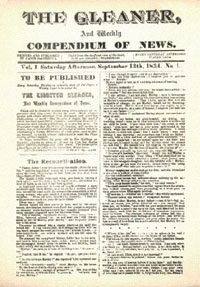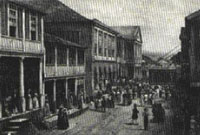From Oral Tradition to the Printing Press in Jamaica: Shaping Literacy and Education
Introduction
The United Nations Educational, Scientific and Cultural Organization (UNESCO) defines literacy as the “ability to identify, understand, interpret, create, communicate, compute and use printed and written materials associated with varying contexts. Literacy involves a continuum of learning in enabling individuals to achieve their goals, to develop their knowledge and potential, and to participate fully in their community and wider society.” In order for any society to meet the above requirements, members must be empowered and exposed to the supporting tools and contexts. This paper seeks to shed light on how education and literacy were impacted with the advent of the printing press in Jamaica.
Context: Before the Printing Press
Jamaica was colonized by the Spanish, who were later defeated and booted off the island by the English in 1655. As the English settled, they began setting up large sugar plantations but never had the manpower to facilitate cultivation. To solve this problem, the indigenous people; the Tainos, were enslaved and later died out because of the hard work and European diseases. This led the English to seek replacements and they headed to West Africa where they imported great numbers of black Africans. As a result, there was a strong presence of Africans and Europeans on the island; with the former treated as the minority group even though they outnumbered the latter.
With a high level of marginalization and neglect, it was up to the Africans to maintain the spirit of community through the way they know best; oral conversations. Therefore, oral tradition or story telling were used to reflect the culture, history and identity of the population. It should be noted that in Jamaica, the concept of learning about culture through written communication was historically foreign (Beecher, 2010). Therefore, storytelling exercises were used to get cultural aspects across to various generations. A character classified as Anancy; which is the spider-god from the Ashanti tribe in Africa was popular among these settings. This wasn’t incidental as most of the slaves were from that tribe and region. Anancy was a trickster who was always trying to outsmart the other animal-gods (Senior, 2003). So popular were these stories that they have made their way into the books of many story-writers and poets literature for students at all level of the education sector.
The Transition: Change on the horizon
Even though some members of the oral community were skeptical about making the total crossover to print, quite a number of them were cognizant that both orality and the growth of literacy out of orality are necessary for the evolution of consciousness (Ong, 2002). The latter notion was to be realized with the advent of the printing press. Printing began in Jamaica in 1718 where the weekly Jamaica Courant was used to spread colonization in the British colonies. Even though this was seen as an advancement, it never resonated with the oppressed as this newspaper was being used to suppress their rights and not to advance their literacy skills. At this particular time printing was seen as of great use and benefit for public intelligence, advertisements and many other things (Cave, 1975, p. 12). In addition, The Courant contained information common to many English colonial newspapers: prices of goods, slave auctions, and shipping news as well as advertisements. Any form of information of interest to the plantation owners and the merchants, the main audience, was deemed worthy of print (Cameron, 2000). This changed the landscape of communication to a great extent as plantation owners were now able to form a community among themselves and would be able to keep abreast of interests unique to them. However, this notion catered to the elite even though it was made to look as if the entire public was involved. The mass of the population was not permitted to attend school and they were also forced to abandon the language they know (Patois) and speak that of the elite (English). As a result, they were not given the basics of literacy and were clueless to what was happening around them. Even though this was inhumane, it created an opening for the launching of literacy on a wide scale across the island. The presence of print could never stay hidden for any long period as soon after there was an influx of printed materials as newspapers accumulated with the passage of time. There was now an obvious connection being made among reading, writing and orality. It was was now obvious that whatever could be said could be written and that written work could be read. Despite the integration of printing at that particular time, it was done in a way to retard progress toward mass literacy. The focus was not to uplift the society and get them educated; rather it was more of a method employed to exhibit control and apply pressure to existing and future slaves. Even though the situation was sad and unfortunate, it was obvious why they were doing it. Keeping the slaves uneducated and illiterate was ideal in getting them to be deprived of information and develop self-consciousness. Also, their cultures and human rights were being trampled upon leading them to refashion their culture. This resulted in them staying quiet even though they existed in what could be termed an oral culture.
Time for real change
The deCardova brothers
As the 1830’s dawned, the Jamaican newspaper continue to evolve with the launching of the Daily Gleaner by the deCardova brothers (Cameron, 2000). At this stage, slaves were now more accomplished and exposed to books and print even though they were not designed for them. Established at an integral time when the slaves were about to be emancipated, a real door was now being opened to satisfy the literacy appetite of the oppressed. Unlike its predecessor, the Daily Gleaner moved from being an advertising sheet and was used to publicize foods for sale. In addition, it was now on sale in rural and urban areas where all parties involved would have equal chance to source information. This shift in print revolutionized the way literacy was now seen and absorbed. With this change, the Gleaner was now seen as a family newspaper devoted literature, morality, arts, science and amusements (Cameron, 2000). This new development affected the social fabric and structure of the society. Civilians were now able to develop a sense of pride, consciousness and identity as they get a taste of what morality entails and how they can go about strengthening their self-esteem. In addition, they were also able to confront print and make the connection with their oral speech. This led to a shift in cultural practices, beliefs and behaviour in general. As a result, political and religious institutions started to pay keen attention to this liberation of literacy. They were now cognizant of the fact that with literacy, persons mindset will be changed and will affect how they view the world. These institutions therefore never had the tight grip they once had on the population and their days of indoctrination was now limited and diminishing at a rapid pace. Persons were now able to make their personal decisions and critically analyze situations as a result of the now frequent interactions with various forms of print. Also, they were able to rise to top positions in politics and religions; hence bridging that wide gap of marginalization and discrimination.
 Front page of the first Gleaner published on September 13, 1834.
Front page of the first Gleaner published on September 13, 1834.
As the printing industry establishes itself, the education sector was now being impacted. The company was now public and they were now involved in charitable causes, and in book publishing, having started to print the “Gleaner Geography and History of Jamaica” in the1920s for use in schools islandwide (Cameron, 2000). This action basically revolutionized the education sector as there was now a direct connection between the printing press and the schools. Through this initiative, the transition was being made from the foundation to get students to get a better understanding of the country’s culture and history. This changed education practices on the island ever since as for the first time on the island, teachers were free to use materials that weren’t controlled by the elite. There was a sense of freedom in instructions and pupils now had control over their own learning. This later enabled them to be more aware of who they were as persons and later got the chance to appreciate their freedom by looking at what their fore-parents went through. Literacy at this phase never only represented reading and writing; but catered to understanding, interpreting, creating, communicating, self-awareness, the ability to think critically, and proper decision making.
 Harbour Street in Kingston, Jamaica 1844, a decade after the Gleaner began.
Harbour Street in Kingston, Jamaica 1844, a decade after the Gleaner began.
Of equal importance, the Gleaner widened its scope in the schools by launching the publication of a school newspaper called the “Children’s Own” in 1950. This was significant as it clearly facilitated reading and writing on a scale that wasn’t seen before. Here students were given the chance to express themselves using a source that was unique to them. Through this medium, they developed as writers and editors and were able function as fully rounded students in the classroom. They finally recognized that what could be said could be written and that written work could be read. In addition, there was now an awareness that reading was a representation of the text in oral form. Even though print was becoming dominant, oral tradition never died as many of the poems, songs and stories that are told to children have not been translated into books or other forms of written media but have been passed on through oral traditions such as storytelling, poetry-reading and drama (Beecher, 2010). Orality was now being transferred to print and the voices of the once voiceless were now at high pitch. There was now a space for the integration of orality and literacy. From such integration, orality-literacy dynamics enter integrally into the modern evolution of consciousness toward both greater interior and greater openness (Ong, 2000). Classrooms were now rich in print and schools started turning out great numbers of successful individuals who later elevated to leadership positions on the island and impacted its growth and development significantly. Also they were able to achieve their goals, develop their knowledge and potential, and participate fully in their community and wider society (UNESCO, 2004).
References
Beecher, M. B. (2010). Oral traditions: A view from Jamaica. Retrieved October 24, 2011 from http://www.tigweb.org/youth-media/panorama/article.html?ContentID=29709&start=
Cameron, L. D. (2000). The Story of the Gleaner Memoirs and Reminiscences. Kingston: The Gleaner Company Ltd.,
Cave, R. (1975). Printing comes to Jamaica. The Jamaica Journal, 9, (2), 11-17,
Ong, W,. (2002). Orality and literacy: The technologizing of the word. London: Methuen.
Tanna, L. (2009). Tales and Oral Histories: J’can folk tales at their best. Kingston: The Daily Gleaner Company Limited.
The Plurality of Literacy and its implications for Policies and Programs. UNESCO Education Sector Position Paper: 13. 2004. Retrieved October 25 2011 from http://unesdoc.unesco.org/images/0013/001362/136246e.pdf
Richards, J. (1969). Early Jamaican printing. The Jamaica Journal, 3, (4), 7-11, http://www.sephardim.org/ jamaica/1700/laguna.html
Senior, O.(2003). The Encyclopedia of the Jamaican Heritage. Kingston:Twin Guinep Publishers,
Sherlock, P., Bennett, H. (1998). The Story of the Jamaican people. Kingston: Ian Randle Publishers.



